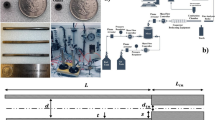Abstract
In recent times, the applications of numerical methods are gaining momentum to carry out critical analysis to identify electrical energy and related emission saving potential on real-time application. The chosen specific area of the current work is the simulation of compressed airflow through pipes. The pressure gradient across compressed air pipe junction was simulated, and the result showed that the minimum pressure drop occurs when a branch line is taken at an angle of 46° with horizontal from the main pipe against the conventional T branch. In case of elbow, 150-mm fillet radius gave minimum pressure drop against 90° elbow. The CFD analysis carried out on T and elbow of compressed air pipe network with various inlet air pressures of 4 × 105, 6 × 105, and 8 × 105 Pa showed that a no. of redesigned junction geometry, which is 5000, can reduce compressor electricity consumption by 127.14 MWh per annum and CO2 emission by 37.31 t per annum.










Similar content being viewed by others
Abbreviations
- C ε1, C ε2 :
-
Standard k-ε model constants
- Dy:
-
No. of days for the year
- E R :
-
Energy recovered (MWh)
- ES i :
-
Energy source i (electricity or fuel wood/Briquette)
- EF i :
-
Emission factor for the fuel type (i)
- H :
-
Operating hour
- INR:
-
Indian Rupees
- N θ :
-
Adiabatic power (kW) at angle θ and is replaced with fillet radius (r) in case of elbows
- n :
-
No. of junctions
- Na:
-
Adiabatic power required (MWh)
- p 1 and p 2 :
-
Initial and final pressure in pascal (absolute)
- Q :
-
Flow rate (m3/h)
- r :
-
Fillet radius
- γ :
-
Compression index, 1.4
- k :
-
Turbulent kinetic energy (m2/s2)
- μ :
-
Dynamic viscosity (kg/ms)
- μ t :
-
Turbulent viscosity (kg/ms)
- σ k :
-
Turbulent Prandtl number for k
- σ ε :
-
Turbulent Prandtl number for ε
- ε :
-
Turbulent dissipation per unit mass
- ρ :
-
Mass density (kg/m3)
- k :
-
Kinetic energy of turbulent fluctuations
References
Abdulwahhab, M., Injeti, N. K., & Dakhil, S. F. (2012). CFD simulations and flow analysis through a t-junction pipe. International Journal of Engineering Science and Technology, 4, 3392–3407.
Central Electricity Authority, G. O. I. (2009). Green house gas emission guidelines for stationary combustion sources. North Carolina Division of Air Quality, www.ncair.org.
Costa, N. P., Maia, R., Pinho, F. T., & Proença, M. F. (2006). Edge effects on the flow characteristics in a 90° tee junction.
Dindorf, R. (2012). Estimating potential energy saving in compressed air system. Procedia Engineering, 39, 204–211.
Eesa, M. (2009). CFD studies of complex fluid flows in pipes. Ph.D, Birmingham.
Gaylard, A. (2001). In: Computational fluid dynamics in practice. Professional Engineering Publishing.
Gielen, D., & Taylor, P. (2009). Indicators for industrial energy efficiency in India. Energy, 34, 962–969.
Guilherme, C. G., Martin, N. R., & Cristina, S. H. (2012). Thermal and air flow simulation of a naturally ventilated shopping mall. International Journal of Energy and Building, 50, 177–188.
György, P., Pinho, F. T., & Maia, R. (2003). Numerical predictions of turbulent flow in a 90° tee junction. The 12th International Conference on Fluid Flow Technologies. Budapest, Hungary.
György, P., Pinho, F. T., & Maia, R. 2006. The effect of corner radius on the energy loss in 90° T-junction turbulent flows. The 13th International Conference on Fluid Flow Technologies. Budapest, Hungary.
Holdsworth, J. (1997). Conserving energy in compressed air systems. Plant Engineering, 51, 103–104.
Joseph, B. (2004). Compressed air supply efficiency. Houston: IETC Conference: Southern California Edison, USA.
Kolmogorov, A. N. (1942) Equations of turbulent motion in an incompressible fluid. Izvestiya Akademii Nauk, Seriya Fizicheskaya 6, 56–58.
Mathur, J., Bansal, N. K., & Wagner, H. J. (2003). Investigation of greenhouse gas reduction potential and change in technological selection in Indian power sector. Energy Policy, 31, 1235–1244.
Mongia, N., Sathaye, J., & Mongia, P. (1994). Energy use and carbon implications in India focus on industry. Energy Policy, 22, 894–906.
Mongia, P., Schumacher, K., & Sathaye, J. (2001). Policy reforms and productivity growth in India's energy intensive industries. Energy Policy, 29, 715–724.
Nikola, T., Goran, J., & Hakon, S. (2011). Cfd analysis and air flow measurements to approach large industrial halls energy efficiency: a case study of a cardboard mill hall. International Journal of Energy and Building, 43, 1200–1206.
Paritosh, R., V. (2007). Fluid flow in T-junction of pipes. Master, Department of Information Technology, Laboratory of Applied Mathematics.
Radgen, P. (2004). Compressed air system audits and benchmarking. 3rd European Congress Economics and Management of Energy in Industry, Estoril-Lisbon. Portugal.
Radgen, P. 2006. Efficiency through compressed air energy audits. Energy Audit Conference.
Radgen, P. & Blaustein, E. (2001). Compressed air systems in the European Union – energy, emissions, saving potentials and policy actions. Stuttgart, Germany.
Saidur, R. (2010). A review on electrical motors energy use and energy savings. Renewable and Sustainable Energy Reviews, 14, 877–898.
Sathaye, J., & Phadke, A. (2006). Cost of electric power sector carbon mitigation in India: international implications. Energy Policy, 34, 1619–1629.
Seddon, J. (1957). The flow through short straight pipes in a compressible viscous stream. London: Aeronautical Research Council by Ministry of Supply.
Terrell, R., E. 1999. Improving compressed air system efficiency. Know what you really need. Energy Engineering, 96, 7–15
Victoria, S. (2009). Energy efficiency, best practice guide, compressed air systems.
Author information
Authors and Affiliations
Corresponding author
Electronic supplementary material
Below is the link to the electronic supplementary material.
ESM 1
(DOCX 599 kb)
Rights and permissions
About this article
Cite this article
Sambandam, M.T., Madlool, N.A., Saidur, R. et al. Investigation of energy saving potentials in T-junction and elbow in compressed air systems. Energy Efficiency 10, 1099–1113 (2017). https://doi.org/10.1007/s12053-016-9493-0
Received:
Accepted:
Published:
Issue Date:
DOI: https://doi.org/10.1007/s12053-016-9493-0




